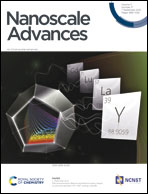Inherent heterogeneities and nanostructural anomalies in organic glasses revealed by EPR†
Abstract
Intriguing heterogeneities and nanostructural reorganizations of glassy ionic liquids (ILs) have recently been found using electron paramagnetic resonance (EPR) spectroscopy. Alkyl chains of IL cations play the key role in such phenomena and govern the anomalous temperature dependence of local density and molecular mobility. In this paper we evidence and study similar manifestations in a variety of common non-IL glasses, which also contain molecules with alkyl chains. A series of phthalates clearly demonstrates very similar behavior to imidazolium-based ILs with the same length of alkyl chain. Glasses of alkyl alcohols and alkyl benzenes show only some similarities to the corresponding ILs, mainly due to a lower glass transition temperature hindering the development of the anomaly. Therefore, we demonstrate the general nature and broad scope of nanoscale structural anomalies in organic glasses based on alkyl-chain compounds. The ‘roadmap’ for their occurrence is provided, which aids in understanding and future applications of these anomalous nanoheterogeneities.



 Please wait while we load your content...
Please wait while we load your content...